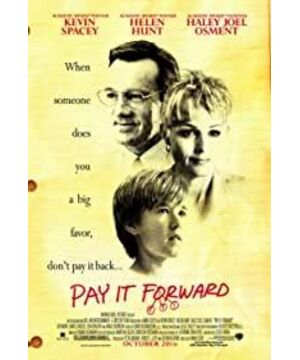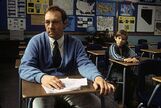One day, the little boy's new sociology teacher left homework: Think of a way to change the world and put it into practice.
The little boy's idea is that everyone sincerely helps three people, and the three people help three people respectively, melt the love into the help, and spread it little by little until it spreads to all corners of the world, thereby changing the world.
The film has two main lines: one is the life of a little boy, and the other is the impact of loving activities.
The little boy's first goal is to help a homeless drug addict. The little boy took him home and gave him money to get back to work. But soon, the addict started taking drugs again and returned to his old life. The little boy's help failed. But later in the film, the drug addict saves a woman who was about to commit suicide.
The second target is his teacher. The little boy tried to bring the teacher and his mother together, but it didn't go well. At first, the teacher felt lost and panicked because his regular life was broken. When he and the little boy's mother embarked on a smooth developmental relationship, the little boy's biological father came back. He's a hooligan who beats the little boy's mom whenever he gets drunk. The mother decides to forgive the little boy's biological father and give him a chance to reform. At this time, the teacher told his mother the reason for his inferiority complex: he also had such a rogue father when he was a child, and he was unfortunately caught by attacking the rogue father in order to protect his mother. Then the rogue dad burned him with gasoline, causing extensive scars on his body now. The little boy's mother was shocked, but still did not change her attitude and forgave the little boy's father. As it turns out, a jerk is always a jerk, and the little boy's mom is in a lot of pain.
The third object of the little boy is an old bullied friend. He wants to help him drive away those bad boys, but when faced with the chaotic scene, he lacks the courage to help.
The little boy had failed all three of his goals, and he was frustrated and devastated.
Second main line:
When a tabloid reporter was covering a kidnapping case, his car was wrecked, and a rich man passing by immediately gave him his car. Then he went to thank the rich man. The rich man said that when he took his daughter with breathing difficulties to the hospital, a black man who was bleeding saw that the nurse would not take action against the girl and threatened the nurse with a gun. In the end, the girl was treated, but he himself was taken away. Before leaving, he told the rich man to help three people. The reporter found the black man again. He said that once he was chased and killed, a female alcoholic who was driving by rescued him and asked him to help three people. The reporter was even more interested and wanted to follow this clue to find the initiator, so they found this woman, who turned out to be the little boy's grandmother. She told reporters about the plan to spread the love. The reporter gave the little boy the opportunity to be interviewed and asked him to explain his reasons for launching the campaign on TV.
Here, the two main lines merge, and the climax of the movie appears. The reporter found the little boy, and the little boy explained his intention to launch this activity: carefully observe the needs of the people around him and help them, because sometimes even they themselves do not understand their own needs; On the fixed track of life, stick to the old rules, want to change all day long but maintain the status quo all day long and refuse to change, even if it is only a step.
The teacher and mother were moved by the little boy, confessed to each other, and decided to reconcile. But at this time, the little boy mustered up the courage to help his bullied partner, but was accidentally stabbed to death in the fight. The little boy's mother and teacher were very sad. Outside the house, they found many people holding candles and flowers to express their feelings for the little boy.
When I first started watching it, I was a little surprised. The difference in values is really big. Americans are too self-righteous, and always want to do their best to change the world and save the world, such as Superman Batman or something. It's just an elementary school assignment, and the teacher asks to change the world. This child is very smart. He used the method of four or two to spread a set of geometric numbers - 3 to the Nth power, and the spread is very wide. He only needs to spread the seeds. At the same time, he is also cute and kind. If you want this world to be full of love, you have to spread love little by little, and spread out layer by layer of radiation.
The little boy is an ordinary little boy, living an ordinary life like other children. I have troubles at home, troubles at school, and at the same time I see that everyone in society has troubles. What is unusual about the little boy is that he has questioned this kind of life that adults are accustomed to, and wants to solve this problem. So, how to solve it? Why is everyone troubled? The little boy thought it was a lack of love. For a person who is in trouble, it may be possible to get out of the quagmire with the help of others. By helping each other, can we solve problems and get out of trouble? So the little boy started this activity. The little boy tried very hard to help others, but the effect was not very good. It's normal, everything can't be smooth sailing. The assumption usually exists in an ideal environment. Once it is put into a complex and contradictory society and collides with various real problems, it must not develop harmoniously. For example, in an ideal environment, everyone is willing to get help, but in reality, due to different personal psychological qualities, some people may temporarily change into the right path by receiving help, but it is difficult to keep moving forward; Willing to accept help; may also forget to help others after receiving help.
However, as long as you work hard and overcome difficulties, the road will always work out. As long as there is a problem, there is a solution. Difficulties and hesitations are only temporary bottoms, and if you persist, you will definitely get out of the haze. Reality is a fluctuating curve, failure or success is temporary, and most of the time it climbs up or down. The film is based on such a wave curve as a clue. Not enabling a smooth start, a major problem in the middle, and then breaking out of the old Hollywood-style finale that solves the perfect ending. But in the development of the storyline, various emotions such as progress and contradiction, effort and confusion intersect with each other, and the activities progress smoothly and alternately. This is more realistic and makes the audience feel empathy.
Actors control their roles very well, whether they are playing teachers, mothers or little boys, they have all kinds of complex emotions in place. The most impressive plot is the heart-piercing and panic when the teacher described the shadow of childhood violence, her body twitching, and the mother's complex eyes of shock, sympathy and contradiction after listening to it. Their perfectly coordinated performances unknowingly impacted the hearts of the audience.
Another deep feeling is the problem of childhood shadow domestic violence. From the film, we can find that most of the unhealthy mental state of adults stems from family shadows in childhood. The little boy's mother's mother was an alcoholic, and the teacher was abused by his father as a child. Their psychological shadows in adulthood have a lot to do with family problems in childhood. Mental healthy and positive children need a healthy family environment, and a healthy family environment needs two qualified parents to build and maintain. I feel that since I have decided to have children, I have decided to be a parent, and I have to shoulder the responsibility. Get rid of all kinds of bad habits such as violence, alcoholism, and drug addiction. If you can't do it, you want to live comfortably and show freedom and individuality, then don't have children. If parents can pay more attention to their children's psychological problems in the future and create a warm and democratic atmosphere, I believe that when children grow up, there will be less psychological shadows that affect their normal lives and positive attitudes.
However, the film also has flaws. At the beginning of the film, the story description is too long and bland, not engaging, and does not attract the audience to quickly enter the film. The director can create a small dramatic conflict and raise suspense. The keynote of the film is a warm and healing theme, and a humorous and warm atmosphere can also be created at the beginning. But at the beginning, it was too bland and even made people feel sad, so that my classmates and I watched it for about ten minutes, and we didn't know what the movie was going to say or aroused the desire to know what the movie was going to say.
The climax of the film is that the little boy gave a touching speech, the mother and the teacher reconciled, the little boy was killed by mistake, and the crowd raised the lights to mourn. The speech given by the little boy is the theme of the film, and it is also the most central part. This part is very good. The expression is concise and concise, and the deep meaning is explained in a simple way. It also understands the righteousness, and concretes the broad and vague love into the strong practicality in reality: helping others and passing on love. This is much more effective than the cheering slogan "I love the motherland and the people". The mother and the teacher were touched and reconciled by the speech, which showed the far-reaching and huge impact of the little boy's speech. The manslaughter of the little boy should symbolize that the road to spreading love is tortuous, and the road is long and long. Then the audience will be very tangled. The mother and the teacher are reconciled, the little boy is dead, what is going on, this child is so sad. But I have to say that the tragic ending is even more impressive and thought-provoking. Finally, when the crowd knew that the little boy was dead, they all came to the little boy's house with candles and flowers to mourn him. The film uses a long shot, allowing the candlelight to form a river of hope. The teacher and mother stand in the middle. The white shirt the teacher wears is especially obvious. The image is vivid on the black background at night, surrounded by stars. In fact, I was a little bit surprised. At the end, the crowd held up the lights in silence, and in the close-up shots, the crowd's eyes were bright and slightly smiling. I guess the director's intention is that the eyes of the masses are full of hope, that the seeds of love have been sown, and they are constantly spreading and growing. But no matter how someone dies, there must be some sadness and sadness. The eyes of the teacher and mother are in place. Some are saddened by the passing of the little boy, and some are moved by the masses to be full of hope again.
View more about Pay It Forward reviews










